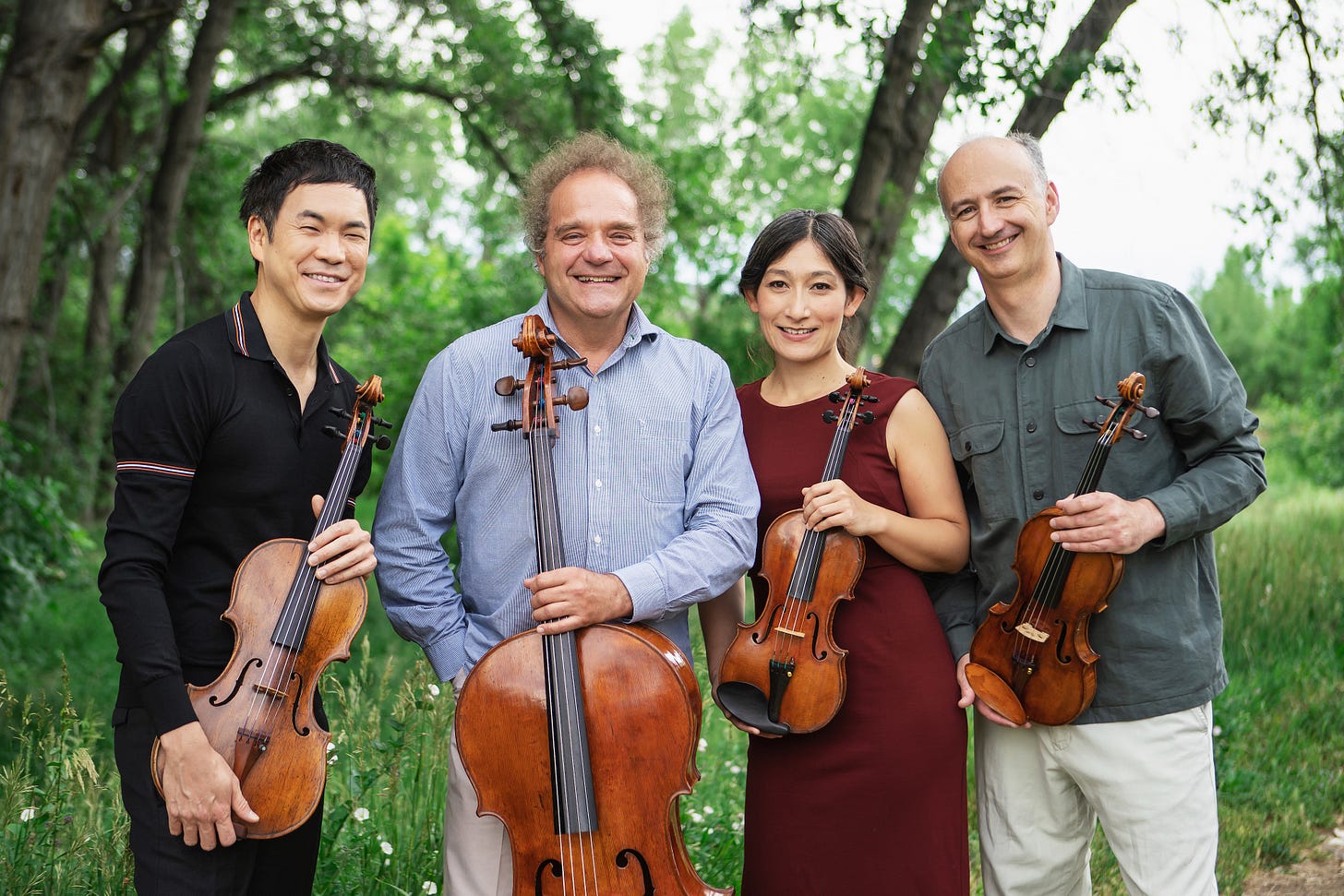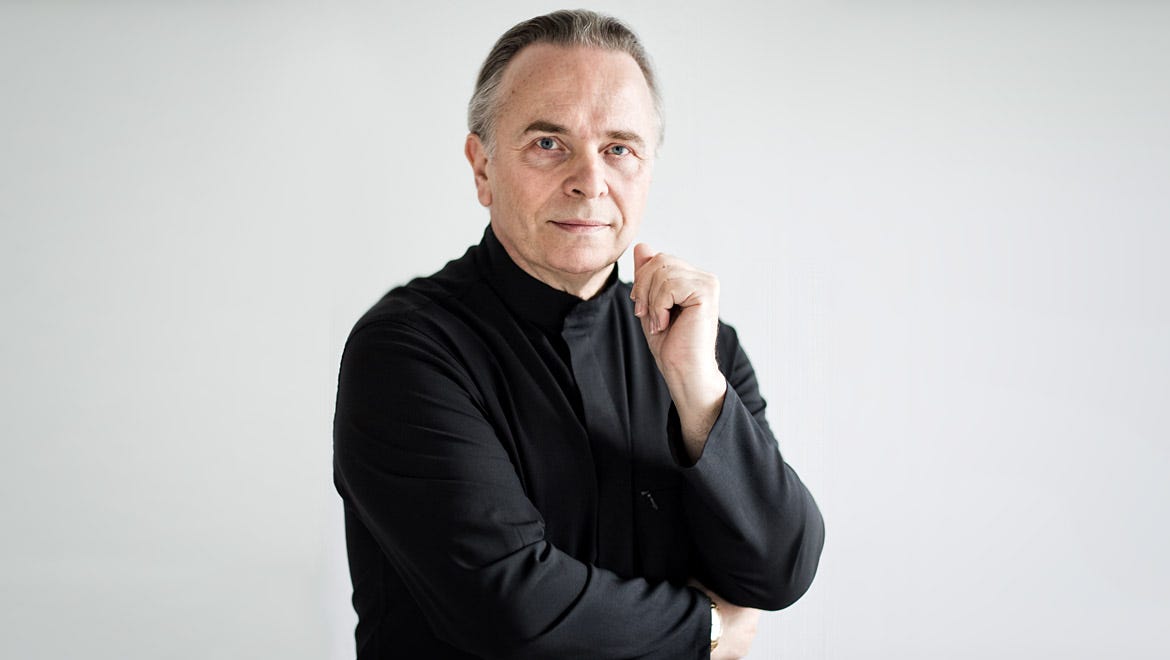The Quartet of Theseus
The shifting character of the Takács Quartet stood out in its recent Berkeley recital
After slaying the Minotaur, so the story goes, Theseus sailed home to Athens, bringing with him the rescued youths who had been held as hostages in Crete. That voyage was such a civic triumph that the Athenians maintained the ship in perpetuity, replacing individual oars and planks and masts as they wore out. Eventually, none of the original parts survived. And yet the craft was still the ship of Theseus — or was it?
This ancient brainteaser reappears in countless different guises across a wide range of subjects, including (notably for our purposes) the world of chamber music. Members of a performing ensemble find each other during their conservatory years, let’s say. They form a group, shaped by the performing approach and musical interests they have in common. Then one of them gets an orchestra job; another relocates to start a family; eventually, a third member’s personal high-handedness becomes too much for the others to take, and he’s given the boot. At each point, a new musician is brought in as a replacement, and through it all the labeling remains the same. (After all, if nothing else, the group has touring commitments and maybe even a record contract by now.) But what does it mean to keep referring to this shifting cast of characters by its original name?
These questions came to mind on Sunday afternoon, when the Takács Quartet returned to UC Berkeley’s Hertz Hall for a recital program of music by Beethoven, Janáček, and Brahms. The Takács, or at any rate four chamber musicians appearing under that name, has been on the scene for half a century now, presenting a diverse repertoire with a particular emphasis on Haydn, Beethoven, and Bartók. Over the years, the quartet has been a frequent visitor to Cal Performances, often appearing multiple times in a season. (They’re due for a return visit on Feb. 16.) There have been periods when I heard them perform regularly, but Sunday’s encounter must have been my first in at least a decade.
I scarcely recognized them. The Takács I remember was a robust, risk-taking ensemble, with a rough-hewn sound and a penchant for pushing dynamics and phrasing as far as they would go. The results could be excessive at times, but when everything was on track, the quartet played with an explosive, probing rigor that was mesmerizing.
Sunday’s recital suggested that other criteria are now in play. The first of Beethoven’s string quartets, Op. 18, No. 1, sounded polite and even a little fussy in its clarity. Each phrase leapt gracefully along as if careful not to make too much trouble for the listeners; I missed the unruly, sometimes unkempt expansiveness of the old days. Some of that quality reappeared in Janáček’s String Quartet No. 1, The Kreutzer Sonata, as the composer’s distinctive brand of abrasive tenderness shone through (especially in the two outer movements).
For me, the afternoon’s high point came after intermission, when pianist Jeremy Denk joined the ensemble for a beautifully streamlined rendition of the Brahms Piano Quintet. With the addition of Denk’s crisp, clean-lined playing, the performance seemed to snap newly into focus. You could hear more reliably where the rhythmic and expressive emphases were meant to fall. The slow movement in particular attained a stately immediacy that brought the listener right in.
In all fairness, my reaction to Sunday’s program must have been due in large part to a sense of disorientation. Perhaps the shift should not be too surprising; these are different instrumentalists from the ones I was used to. In its original incarnation, the Takács Quartet was an all-Hungarian ensemble, formed in 1975 when its members were students at the Music Academy in Budapest. By the time the group began appearing here regularly in the 1990s, two of the founding members had been replaced. Today, only cellist András Fejér remains of the original lineup. First violinist Edward Dusinberre is the other longstanding member of the group; second violinist Harumi Rhodes and violist Richard O’Neill are more recent additions. (Bay Area audiences might remember the period during which Geraldine Walther, former principal violist of the San Francisco Symphony, was a member of the quartet.)
Perhaps this is just the way successful musical enterprises make their way, evolving through gradual, imperceptible shifts. Or at least, some of them do. The Kronos Quartet is about to begin its second half-century with only founder and artistic director David Harrington on board, but his single-minded leadership promises to keep the group’s artistic priorities intact. The ship of Theseus sails ever onward.
Fauning over Kim
Here’s my proposal for the continuing health and welfare of the San Francisco Symphony: As long as Yubeen Kim is the orchestra’s principal flutist, let’s just program Debussy’s Prelude to the Afternoon of a Faun every season. Maybe twice. What could go wrong?
I tend to think of Debussy’s Impressionist masterpiece as an orchestral work that begins with a notable flute solo. But when the Symphony performed it in Davies Symphony Hall on Saturday night, it landed as something else: A flute concerto by other means. The flute is everywhere in that score — singing its sinuous melodies, dancing around the edges of the texture, inspiring the rest of the orchestra even when it’s not actually taking a lead role. Kim’s artistry, marked by an extravagantly plush, golden sound that he shapes with insouciant directness, drew attention without a hint of showboating or domination. The man just does what he does, and his playing lends grace and sublimity to everything around him.
Leading the orchestra was the venerable British conductor Mark Elder, making an astonishingly late debut with the organization. Elder’s devotion to Berlioz showed up in two of the composer’s concert overtures, the one to the partially lost early opera Les Francs-juges and the standalone Le roi Lear. As always, Berlioz’s weird, unclassifiable imagination pays dividends in both works, including the ominously dark coloration of the former and the theatrical flair of the latter (including an extended soliloquy by the cellos and basses lifted without fear or embarrassment from Beethoven’s Ninth Symphony).
Yet for such a committed advocate, Elder struggled to make the case for either work as strongly as I’d hoped. Orchestral balances were often murky, and ensemble playing was more ragged in spots than one would wish. The same problems prevailed after intermission in Strauss’s Also sprach Zarathustra, which sounded oddly slovenly even with luminous solos from concertmaster Alexander Barantschik and his fellow string principals. Short Ride in a Fast Machine, John Adams’ brief, brilliantly chug-chugging curtain-raiser, turned out to make an equally effective closer; color me surprised.
Elsewhere:
Rebecca Wishnia, San Francisco Chronicle/SFCV: “Guest conductor Mark Elder led the concert, and if the performance was somewhat subdued, the programming itself was invigorating.”
Stephen Smoliar, The Rehearsal Studio: “Last night’s program concluded with one of John Adams’ most engaging compositions, Short Ride in a Fast Machine. This quickly blew away any of the scholarly cobwebs that may have been induced by Strauss’ musical reflections on Nietzsche!”
Cryptic clue of the week
From Out of Left Field #252 by Henri Picciotto and me, sent to subscribers last Thursday:
Coco gets adult rating, being full of dead bodies (7)
Last week’s clue:
Kitty is entertaining leader of Denmark (4)
Solution: FUND
Kitty: definition
entertaining: FUN
leader of Denmark: D
Coming up
SoundBox: The San Francisco Symphony’s embattled new-music venue and performance series presents a program curated by pianist, composer, and MacArthur Foundation fellow Courtney Bryan. The program promises a sampling of music from the African diaspora, including works by George Lewis, Tania León, Tyshawn Sorey, and more. Jan. 31-Feb. 1, SoundBox. www.sfsymphony.org.
Before and After Nature: Pulitzer Prize-winning composer David Lang presents the world premiere of a work that promises a contemplation of Earth’s existence before and after the presence of humanity. The Bang on a Can All-Stars and Los Angeles Master Chorale combine forces for the performance, which also features video and projections by Tal Rosner. Feb. 1, Bing Concert Hall, Stanford. live.stanford.edu.









Love the Theseus analogy. I’ve often wondered the same but not so eloquently!
I came out of the symphony concert thinking that Hector B.'s reputation as a less than first rate composer was indeed secure! I also wish we got to hear that organ more often.